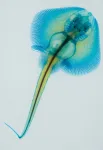(Press-News.org) Permanent magnets, the kind found on refrigerators everywhere, exist because their constituent atoms behave as miniature magnets. They align and combine to form the larger magnet in a phenomenon called ferromagnetism. There are some materials where the atomic magnets instead form an alternating pattern, so the material has no net magnetization. Such antiferromagnets have attracted attention for their potential to create faster and more compact magnetic memory devices for computing.
Realizing the full potential of antiferromagnetic devices will require sensing their atom-to-atom magnetic patterns, something that has not yet been achieved. However, researchers at the University of Illinois Urbana-Champaign led by Pinshane Huang, a professor of materials science & engineering, have made progress toward this goal. In the journal Ultramicroscopy, they report a new electron microscopy technique that can resolve magnetic behavior on the scale of angstroms—tenths of nanometers, nearly on the scale of individual atoms. They use this technique to fully resolve the antiferromagnetic order in iron arsenide for the first time.
“We are working to develop new techniques that can resolve magnetic behavior of individual atoms, and this study is an important step,” Huang said. “The best techniques before now have achieved resolutions of a few nanometers. We have vastly exceeded that record.”
Microscopic magnetism is often measured with scanning transmission electron microscopy, or STEM, in which an electron beam is focused into a material. The electric interactions between the beam and the material’s structure have been famously used to provide images of individual atoms in the material, but the beam also interacts with the material’s magnetic structure. Although this much weaker interaction is enough to determine the longer-range magnetic order found in ferromagnets, a far more precise technique is needed to observe the atom-to-atom variation in antiferromagnets.
“In standard, low-resolution STEM experiments, the magnetic interaction can be understood as a small deflection of the electron beam,” said Kayla Nguyen, a postdoctoral research associate and co-lead author of the study. “On the scale of individual atoms, though, this picture breaks down. The magnetic interactions create complicated and subtle signals in the beam pattern which require new tools to analyze and understand.”
To achieve higher resolution, the researchers turned to a more powerful method called four-dimensional STEM. Standard STEM techniques record drops in the beam’s intensity as it interacts with the material, but 4D-STEM captures full two-dimensional scattering patterns as the electron beam scans along the two directions of the material’s surface (for four-dimensional data). These data allowed the researchers to search the full beam patterns for the more intricate signals of atomic antiferromagnetism.
A crucial step of the analysis was simulating the magnetic fields within the iron arsenide sample, for which the researchers wrote a software package called Magnstem. Graduate student and co-lead author Jeffrey Huang explained that the package allowed them to add magnetic effects specific to their material and study the effects they had on electron beam patterns.
“Magnstem simulations allowed us to compare the electron patterns with magnetic effects turned on versus turned off, something that would be quite difficult to do in a real experiment,” he said. “We saw that the effects of the magnetic and electric signals occur on different parts of the pattern and can be extracted separately.”
By combining 4D-STEM with Magnstem simulations, the researchers resolved magnetic order down to 6 angstroms. While this does not resolve magnetic effects on the scale of individual atoms, it allowed them to resolve the antiferromagnetic pattern of iron arsenide, which repeats in cells of 12 atoms.
“Our work has shown it is possible to resolve small-scale magnetic order in electron microscopy experiments and in simulations, almost at atomic resolution,” P. Huang said. “We are actively developing techniques that will build on this result.”
#
The researchers worked in collaboration with the research groups of Daniel Shoemaker and André Schleife, both professors of materials science & engineering. Shoemaker’s group produced samples of iron arsenide, and Schleife’s group performed simulations of the material’s magnetic structure.
This work was supported by the Air Force Office of Scientific Research and the Illinois Materials Research Science and Engineering Center funded through the National Science Foundation. Nguyen is supported by a L’Oreal Fellowship for Women in Science. This research made use of the electron microscopy facilities in the Materials Research Laboratory at the University of Illinois Urbana-Champaign.
END
UIUC researchers image magnetic behavior at the smallest scales to date
2023-04-12
ELSE PRESS RELEASES FROM THIS DATE:
Henry Ford Health cardiologists first in US to successfully implant novel tricuspid LuX valve
2023-04-12
DETROIT (April 12, 2023) – Henry Ford Hospital structural heart interventional cardiologists Pedro Villablanca, M.D., and Brian O’Neill, M.D., are the first in the U.S. to successfully implant the new transcatheter tricuspid valve replacement device LuX-Valve Plus™ for the treatment of patients with symptomatic tricuspid valve disease for whom traditional open-heart surgery is too high of a risk.
“These are patients with severe tricuspid regurgitation who have no other options available to them in the U.S., based on the anatomy of their native valve and medical complexities,” ...
Optically controlled metasurfaces for dynamic dual-mode modulation
2023-04-12
Dynamic control of terahertz (THz) waves at-will with an ultracompact device is important for THz technologies in biomedical imaging, telecommunications, detection, and beyond. However, tunable THz devices made of conventional materials are usually bulky, and they tend to have limited modulation depths and functionalities, due to weak interactions between naturally existing materials and THz waves. Metasurfaces – functional materials endowed with unparalleled flexibility to manipulate light at the deep-subwavelength scale – provide ...
Whether physical exertion feels ‘easy’ or ‘hard’ may be due to dopamine levels, study suggests
2023-04-12
Dopamine, a brain chemical long associated with pleasure, motivation and reward-seeking, also appears to play an important role in why exercise and other physical efforts feel “easy” to some people and exhausting to others, according to results of a study of people with Parkinson’s disease led by Johns Hopkins Medicine researchers. Parkinson’s disease is marked by a loss of dopamine-producing cells in the brain over time.
The findings, published online April 1 in NPG Parkinson’s Disease, could, the researchers say, eventually lead to more effective ways to help people establish and stick with exercise ...
Open-label placebo improved outcomes for people in treatment for opioid use disorder
2023-04-12
BOSTON – There were more than 100,000 reported deaths from opioid overdoses in 2021, according to the Centers for Disease Control and Prevention. Methadone treatment remains one of the most reliable means of treating opioid use disorder, with success rates reportedly ranging from 60 to 90 percent for patients who stick with the long-term regimen. Adherence, though, remains a challenge.
In a novel randomized clinical trial published in JAMA Network Open, senior author Ted J. Kaptchuk at Beth Israel Deaconess Medical Center ...
New agreement will help researchers study metal worlds of M-type asteroids
2023-04-12
ORLANDO, April 12, 2023 – A University of Central Florida researcher will be using the newly constructed Two-meter Twin Telescope (TTT) in the Canary Islands, Spain, to study metal-rich M-type asteroids.
The work can inform the study of asteroids like 16 Psyche, an M-type, or metal, asteroid NASA is launching a mission in October 2023 to visit.
The M-type asteroids offer both high concentrations of metals that could be harnessed to make structures in space as well as clues to the formation of ...
Innovative healthcare extension project enables community-based physicians to diagnose autism in young children
2023-04-12
As the number of children in need of access to timely evaluation and intervention for autism spectrum disorder (ASD) continues to rise, new research is showing how barriers to diagnoses and treatment can be reduced through an innovative training program first developed at the University of Missouri.
ASD can be identified and diagnosed in young children by a well-trained clinician, and early diagnosis is vital to quickly establishing access to evidence-based therapies and interventions. However, long specialty center waitlists, distance, and ...
MD Anderson Research Highlights: AACR 2023 Special Edition
2023-04-12
HOUSTON ― The University of Texas MD Anderson Cancer Center’s Research Highlights showcases the latest breakthroughs in cancer care, research and prevention. These advances are made possible through seamless collaboration between MD Anderson’s world-leading clinicians and scientists, bringing discoveries from the lab to the clinic and back.
This special edition features presentations by MD Anderson researchers at the American Association for Cancer Research (AACR) Annual Meeting 2023. In addition to these studies, forthcoming press releases will feature groundbreaking research on perioperative immunotherapy for operable lung cancer (Abstract CT005), ...
Scientists sequence genome of little skate, the stingray’s cousin
2023-04-12
Rutgers geneticists, working with an international team of scientists, have conducted the most comprehensive sequencing yet of the complete DNA sequence of the little skate – which, like its better-known cousin, the stingray, has long been viewed as enigmatic because of its shape.
The scientists, writing in Nature, reported that by studying the intricacies of Leucoraja erinacea’s genome, they have gained a far better understanding of how the fish evolved from its ancestor – which possessed a much narrower body – over a period of 300 million years to become a flat, winged bottom-dweller.
“We ...
The brain’s support cells may play a key role in OCD
2023-04-12
A type of cell usually characterized as the brain’s support system appears to play an important role in obsessive-compulsive disorder-related behaviors, according to new UCLA Health research published April 12 in Nature.
The new clue about the brain mechanisms behind OCD, a disorder that is incompletely understood, came as a surprise to researchers. They originally sought to study how neurons interact with star-shaped “helper” cells known as astrocytes, which are known to provide support and protection to neurons.
However, ...
Pragmatica-Lung Study, a streamlined model for future cancer clinical trials, begins enrolling patients
2023-04-12
The National Cancer Institute, part of the National Institutes of Health (NIH), has helped launch a phase 3 randomized clinical trial (NCT05633602) of a two-drug combination to treat patients with advanced non-small cell lung cancer (NSCLC). Called the Pragmatica-Lung Study (or S2302), this is one of the first NCI-supported clinical trials to use a trial design that removes many of the barriers that prevent people from joining clinical trials. This “pragmatic” approach aims to increase accessibility ...





